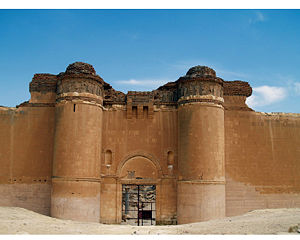
Qasr Alheer Alsharqi
Encyclopedia

Syrian Desert
The Syrian Desert , also known as the Syro-Arabian desert is a combination of steppe and true desert that is located in the northern Arabian Peninsula covering 200,000 square miles . also the desert is very rocky and flat...
. It was built by the Umayyad
Umayyad
The Umayyad Caliphate was the second of the four major Arab caliphates established after the death of Muhammad. It was ruled by the Umayyad dynasty, whose name derives from Umayya ibn Abd Shams, the great-grandfather of the first Umayyad caliph. Although the Umayyad family originally came from the...
caliph Hisham ibn Abd al-Malik
Hisham ibn Abd al-Malik
Hisham ibn Abd al-Malik 10th Umayyad caliph who ruled from 723 until his death in 743. When he was born in 691 his mother named him after her father....
in 728-29 CE in an area rich in desert
Desert
A desert is a landscape or region that receives an extremely low amount of precipitation, less than enough to support growth of most plants. Most deserts have an average annual precipitation of less than...
fauna. It was apparently used as a military and hunting outpost. The palace is the counterpart of Qasr al-Hayr al-Gharbi, a nearby castle palace built one year earlier.
Location
Qasr al-Hayr al-Sharq is 10 kilometres (6.2 mi) from al-SukhnahAl-Sukhnah
Al-Sukhnah is a town in eastern Syria under the administration of the Homs Governorate, located between Palmyra and ar-Raqqah. Together with its satellite villages of al-Kawm and Tayyibah, al-Sukhnah had a population of 15,000 in 1989...
and 100 kilometres (62.1 mi) from Sergiopolis (Rusafa), near Bishri Mountain near Palmyran Middle Mountains.
Architecture
The palace consists of a large open courtyard surrounded by thick bulwarks and towers guarding the entrances as well as each corner. The palacePalace
A palace is a grand residence, especially a royal residence or the home of a head of state or some other high-ranking dignitary, such as a bishop or archbishop. The word itself is derived from the Latin name Palātium, for Palatine Hill, one of the seven hills in Rome. In many parts of Europe, the...
consists of two square structures, one with a diameter of 300m and the other of 100 metres (328.1 ft). The palace(s) contains remnants of rooms, arches and columns which seem to be parts of a huge royal complex. Some of the decorated parts have been moved to the National Museum of Damascus
National Museum of Damascus
The National Museum of Damascus is a large museum in the heart of Damascus, Syria. The most popular part of the museum is the reconstruction of the 2nd century CE Dura-Europos synagogue.- Location :...
while the gate has been reconstructed in the Deir ez-Zor Museum
Deir ez-Zor Museum
The Deir ez-Zor Museum is a museum devoted to the archaeology and history of northeastern Syria, an area more commonly known as the Jezirah, or Upper Mesopotamia. The museum is located in Deir ez-Zor, the capital of Deir ez-Zor Governorate, Syria. It was founded in 1974 and housed in a gallery of...
.
The bigger palace has been several floors, with a huge gate and many towers. Towers were not built as defensive measures. There were also olive yards. The palaces were supplied with water by nearby Byzantine
Byzantine
Byzantine usually refers to the Roman Empire during the Middle Ages.Byzantine may also refer to:* A citizen of the Byzantine Empire, or native Greek during the Middle Ages...
church by a canal 5700 metre long. The palaces contained bathrooms, water reservoirs, mosques and gardens.
World Heritage Status
This site was added to the UNESCOUNESCO
The United Nations Educational, Scientific and Cultural Organization is a specialized agency of the United Nations...
World Heritage Tentative List on June 8, 1999 in the Cultural category.
See also
- List of castles in Syria
- Qasr al-Hayr al-Gharbi

